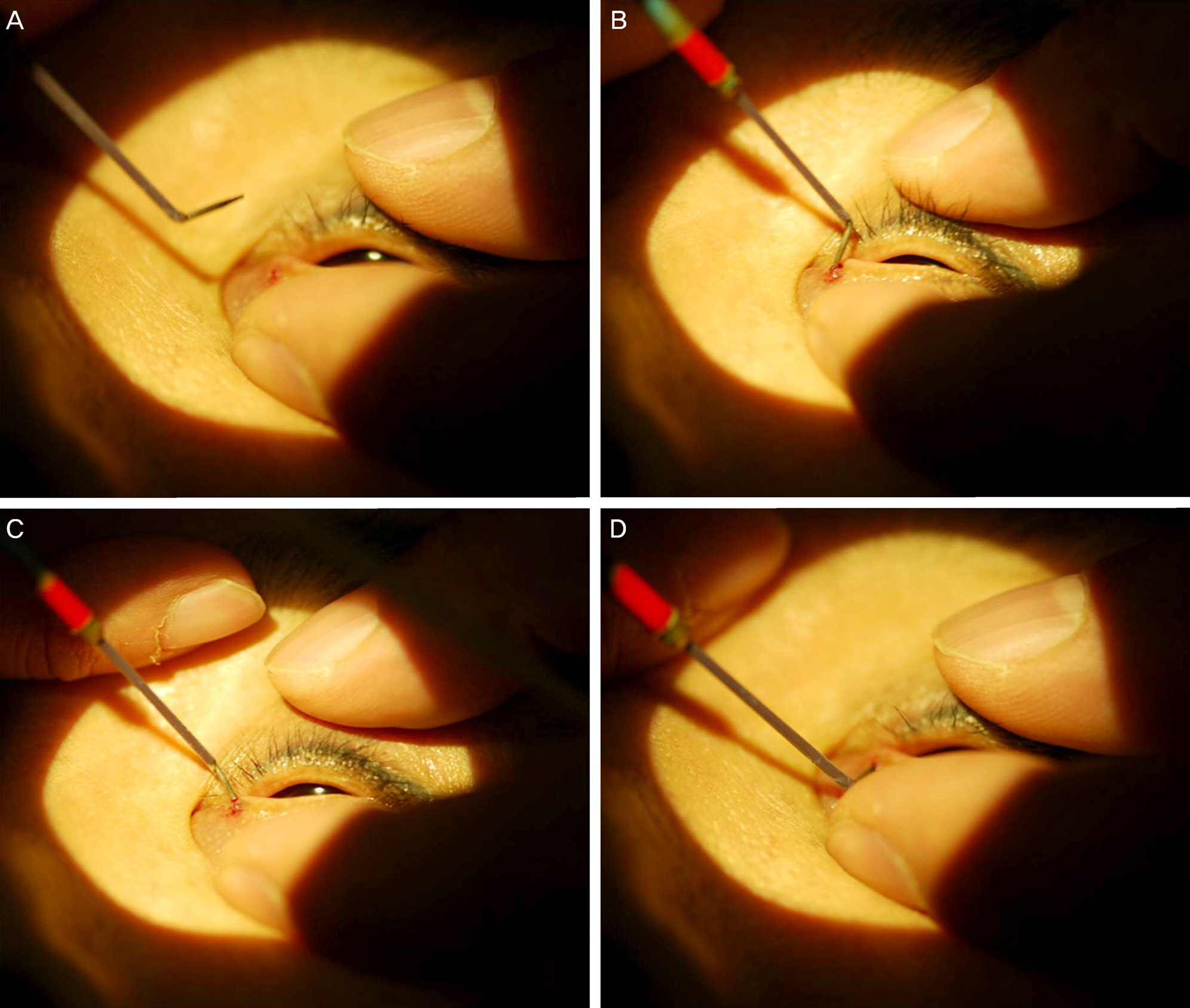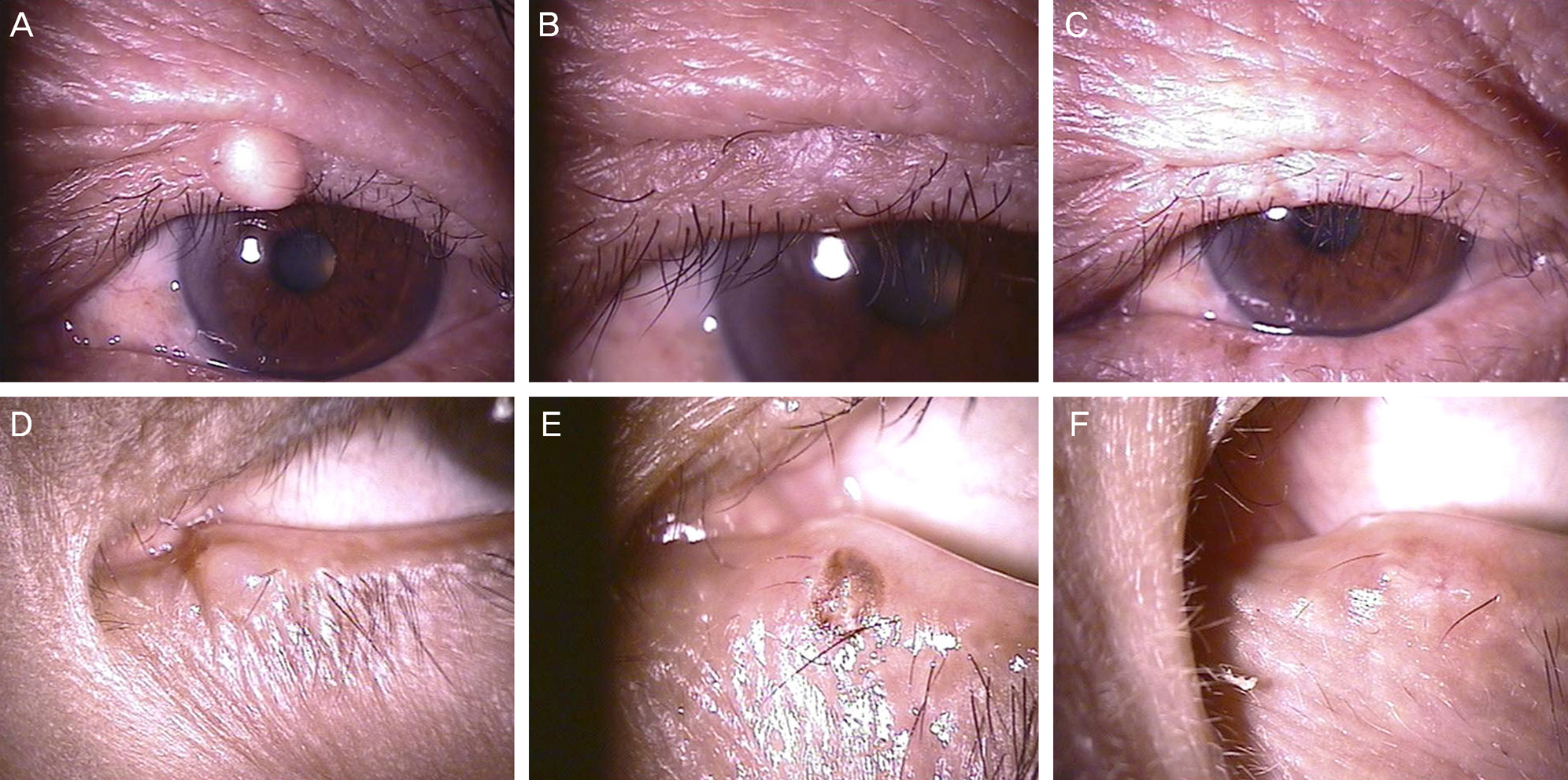J Korean Ophthalmol Soc.
2014 Dec;55(12):1727-1733. 10.3341/jkos.2014.55.12.1727.
Removal of Eyelid Epidermal Cyst Using High-Frequency Radio-Wave Electrosurgery
- Affiliations
-
- 1Department of Ophthalmology, Dongguk University Gyeongju Hospital, Dongguk University College of Medicine, Gyeongju, Korea. ophho@hanmail.net
- KMID: 2338952
- DOI: http://doi.org/10.3341/jkos.2014.55.12.1727
Abstract
- PURPOSE
To introduce an effective new surgical approach with high-frequency radio-wave electrosurgery to remove eyelid epidermal cysts.
METHODS
Thirteen patients (13 eyes) with eyelid epidermal cysts were enrolled in the present study. All patients underwent high-frequency radio-wave electrosurgery (Ellman surgitron(R)) to remove the epidermal cyst. The results were analyzed retrospectively, after a follow-up of more than 6 months.
RESULTS
At 6 months postoperatively, all eyes showed no recurrence of epidermal cyst. Additionally, no complications were reported by any patient.
CONCLUSIONS
High-frequency radio-wave electrosurgery is an effective procedure to remove eyelid epidermal cyst without recurrence.
MeSH Terms
Figure
Cited by 1 articles
-
The Effects of Surgery for Conjunctival Lymphangiectasia Using a High-frequency Radio Wave Electrosurgical Unit
Hyun Kyo Jeong, Hyo Song Park, Kyoung Yul Seo, Jeihoon Lee
J Korean Ophthalmol Soc. 2018;59(4):314-318. doi: 10.3341/jkos.2018.59.4.314.
Reference
-
References
1. Kim SY, Park KY, Oh JW, et al. Epidermal and adnexal nevi and tumors. Korean Dermatology Association Textbook Editing Board. Dermatology. 6th ed.Seoul: Medbook;2014. chap. 26.2. Thomas VD, Snavely NR, Lee KK, et al. Benign epithelial tumors, hamartomas, and hyperplasias. Goldsmith LA, Katz SI, Gilchrest BA, editors. Fitzpatrick's dermatology in general medicine. 8th ed.Newyork: McGraw-Hill professional publishing;2012. chap. 118.3. Yanoff M, Sassani JW. Ocular pathology. 6th ed.Maryland Heights, Missouri: Mosby Elsevier;2009. p. 188–9.4. Itoh Y, Watanabe Y, Henta T, Ishibashi A. Endoscopic extraction and curettage of epidermal cysts on the face. Br J Plast Surg. 1999; 52:182–4.
Article5. Klin B, Ashkenazi H. Sebaceous cyst excision with minimal surgery. Am Fam Physician. 1990; 41:1746–8.6. Jordan DR. Multiple epidermal inclusion cysts of the eyelid: a simple technique for removal. Can J Ophthalmol. 2002; 37:39–40.
Article7. Moore C, Greer DM Jr. Sebaceous cyst extraction through mini-incisions. Br J Plast Surg. 1975; 28:307–9.
Article8. Yang HJ, Yang KC. A new method for facial epidermoid cyst removal with minimal incision. J Eur Acad Dermatol Venereol. 2009; 23:887–90.
Article9. Lucarelli MJ, Ahn HB, Kulkarni AD, Kahana A. Intratarsal epidermal inclusion cyst. Ophthal Plast Reconstr Surg. 2008; 24:357–9.
Article10. Vagefi MR, Lin CC, McCann JD, Anderson RL. Epidermoid cyst of the upper eyelid tarsal plate. Ophthal Plast Reconstr Surg. 2008; 24:323–4.
Article11. Kim TJ, Kim N, Park HJ, et al. A case of eyelid steatocystoma. J Korean Ophthalmol Soc. 2012; 53:1027–9.
Article12. Kronish JW, Sneed SR, Tse DT. Epidermal cysts of the eyelid. Arch Ophthalmol. 1988; 106:270.
Article13. Lieblich LM, Geronemus RG, Gibbs RC. Use of a biopsy punch for removal of epithelial cysts. J Dermatol Surg Oncol. 1982; 8:1059–62.
Article14. Lee HE, Yang CH, Chen CH, et al. Comparison of the surgical outcomes of punch incision and elliptical excision in treating epidermal inclusion cysts: a prospective, randomized study. Dermatol Surg. 2006; 32:520–5.
Article15. Mehrabi D, Leonhardt JM, Brodell RT. Removal of keratinous and pilar cysts with the punch incision technique: analysis of surgical outcomes. Dermatol Surg. 2002; 28:673–7.
Article16. Notowicz A. Treatment of lesions of steatocystoma multiplex and other epidermal cysts by cryosurgery. J Dermatol Surg Oncol. 1980; 6:98–9.17. Vivakananthan C. Minimal incision for removing sebaceous cysts. Br J Plast Surg. 1972; 25:60–2.
Article18. Zuber TJ. Minimal excision technique for epidermoid (sebaceous) cysts. Am Fam Physician. 2002; 65:1409–12. 1417–8. –1420.19. Oliveira AS, Picoto AS, Verde SF, Martins O. A simple method of excising tricholemmal cysts from the scalp. J Dermatol Surg Oncol. 1979; 5:625–7.
Article20. Hurwitz JJ, Johnson D, Howarth D, Molgat YM. Experimental treatment of eyelashes with high-frequency radio wave electrosurgery. Can J Ophthalmol. 1993; 28:62–4.21. Suh JS, Choi S. The effect of conjunctivochalasis surgery using a high-frequency radio-wave electrosurgical unit. J Korean Ophthalmol Soc. 2012; 53:1571–6.
Article22. Youm DJ, Kim JM, Choi CY. Simple surgical approach with high-frequency radio-wave electrosurgery for conjunctivochalasis. Ophthalmology. 2010; 117:2129–33.
Article23. Huang SK. Advances in applications of radiofrequency current to catheter ablation therapy. Pacing Clin Electrophysiol. 1991; 14:28–42.
Article24. Han KE, Choi CY, Seo KY. Removal of lymphangiectasis using high-frequency radio wave electrosurgery. Cornea. 2013; 32:547–9.
Article
- Full Text Links
- Actions
-
Cited
- CITED
-
- Close
- Share
- Similar articles
-
- Two Cases of Corneal Neovascularization Treatment Using High-frequency Radio Wave Electrosurgery
- Evaluation of Subconjunctival Remnant Particles after High-frequency Radio-wave Electrosurgery for Conjunctivochalasis
- Treatment of Trichiasis and Districhiasis with Ellman Dento-Surg 90FFP
- Acute Exacerbation of Conjunctival Papilloma after High-frequency Radio Wave Electrosurgery for Conjunctivochalasis: A Case Report
- The Effect of Conjunctivochalasis Surgery Using a High-Frequency Radio-Wave Electrosurgical Unit





